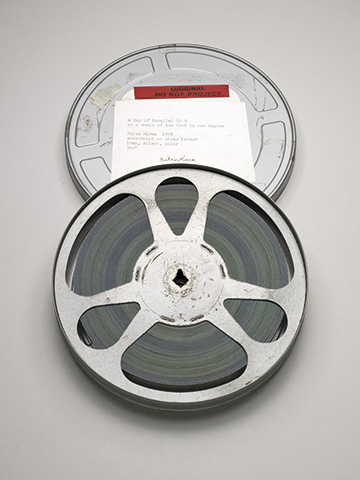Arquivo
2014
EXPOSIÇÃO
Helen Mirra
Habitat de Transição – Apêndice Biblioteca
Edge Habitat – Appendix Library
Edge Habitat – Appendix Library

Mapa do paralelo 52˚ N à escala de uma polegada por um grau de longitude, 1999
Aguarela sobre película de filme 16 mm (360')
Aguarela sobre película de filme 16 mm (360')
Curadoria Miguel Wandschneider
Numa sala da Culturgest no Porto, podemos ver dois filmes de Helen Mirra, escutar música que ela compôs e gravou, e folhear livros concebidos pela artista ou catálogos acerca do seu trabalho. Esta sala funciona como uma adenda à exposição de Helena Mirra em Lisboa. Os dois filmes em 16 mm (coloridos à mão) têm uma relação umbilical com os mapas visuais de diferentes latitudes que são apresentados em Lisboa. E põem em perspetiva a referência ao cinema, e mais particularmente à materialidade da película de filme, nas obras que constituem o núcleo duro da exposição em Lisboa: as faixas de tecido de algodão tingido monocromaticamente, com 16 mm de altura e extensão variável, frequentemente usadas pela artista como suporte para texto datilografado. Ao escutarmos os discos gravados pela artista, somos levados a pensar na qualidade rítmica daquelas obras, resultantes da segmentação das faixas de tecido ou de certos usos do texto. Já os livros que a artista publicou são diretamente reportáveis a algumas dessas obras.
In a room at Culturgest in Porto, we can watch two films by Helen Mirra, listen to music that she herself composed and recorded, and thumb through some books conceived by the artist or some catalogues about her work. This room serves as an appendix to Helen Mirra's exhibition in Lisbon. The two (hand-coloured) 16 mm films are umbilically connected to the visual maps of different latitudes displayed in Lisbon, putting into perspective the references to cinema, and even more so to the materiality of the film strip itself, in the works that form the core of her Lisbon exhibition: the strips of cotton fabric dyed in single colours, 16 millimetres high and of varying lengths, which are frequently used by the artist as a support for the typing of text. As we listen to the music recorded by the artist, we are led to think about the rhythmic quality of those works, resulting from the segmentation of the cotton strips or certain uses of text. The books that the artist published are directly linked to some of these works.
